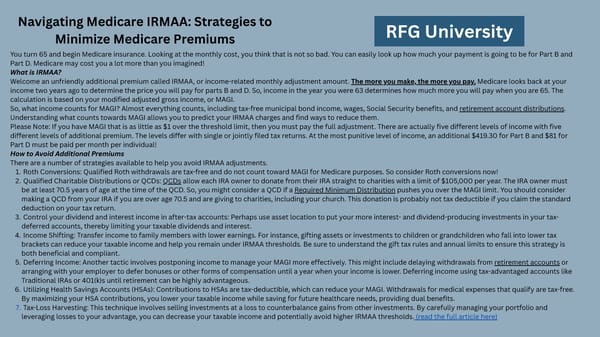You turn 65 and begin Medicare insurance. Looking at the monthly cost, you think that is not so bad. You can easily look up how much your payment is going to be for Part B and Part D. Medicare may cost you a lot more than you imagined! What is IRMAA? Welcome an unfriendly additional premium called IRMAA, or income-related monthly adjustment amount. The more you make, the more you pay. Medicare looks back at your income two years ago to determine the price you will pay for parts B and D. So, income in the year you were 63 determines how much more you will pay when you are 65. The calculation is based on your modified adjusted gross income, or MAGI. So, what income counts for MAGI? Almost everything counts, including tax-free municipal bond income, wages, Social Security benefits, and retirement account distributions. Understanding what counts towards MAGI allows you to predict your IRMAA charges and find ways to reduce them. Please Note: If you have MAGI that is as little as $1 over the threshold limit, then you must pay the full adjustment. There are actually five different levels of income with five different levels of additional premium. The levels differ with single or jointly filed tax returns. At the most punitive level of income, an additional $419.30 for Part B and $81 for Part D must be paid per month per individual! How to Avoid Additional Premiums There are a number of strategies available to help you avoid IRMAA adjustments. 1. Roth Conversions: Qualified Roth withdrawals are tax-free and do not count toward MAGI for Medicare purposes. So consider Roth conversions now! 2. Qualified Charitable Distributions or QCDs: QCDs allow each IRA owner to donate from their IRA straight to charities with a limit of $105,000 per year. The IRA owner must be at least 70.5 years of age at the time of the QCD. So, you might consider a QCD if a Required Minimum Distribution pushes you over the MAGI limit. You should consider making a QCD from your IRA if you are over age 70.5 and are giving to charities, including your church. This donation is probably not tax deductible if you claim the standard deduction on your tax return. 3. Control your dividend and interest income in after-tax accounts: Perhaps use asset location to put your more interest- and dividend-producing investments in your tax- deferred accounts, thereby limiting your taxable dividends and interest. 4. Income Shifting: Transfer income to family members with lower earnings. For instance, gifting assets or investments to children or grandchildren who fall into lower tax brackets can reduce your taxable income and help you remain under IRMAA thresholds. Be sure to understand the gift tax rules and annual limits to ensure this strategy is both beneficial and compliant. 5. Deferring Income: Another tactic involves postponing income to manage your MAGI more effectively. This might include delaying withdrawals from retirement accounts or arranging with your employer to defer bonuses or other forms of compensation until a year when your income is lower. Deferring income using tax-advantaged accounts like Traditional IRAs or 401(k)s until retirement can be highly advantageous. 6. Utilizing Health Savings Accounts (HSAs): Contributions to HSAs are tax-deductible, which can reduce your MAGI. Withdrawals for medical expenses that qualify are tax-free. By maximizing your HSA contributions, you lower your taxable income while saving for future healthcare needs, providing dual benefits. 7. Tax-Loss Harvesting: This technique involves selling investments at a loss to counterbalance gains from other investments. By carefully managing your portfolio and leveraging losses to your advantage, you can decrease your taxable income and potentially avoid higher IRMAA thresholds. (read the full article here) RFG University Navigating Medicare IRMAA: Strategies to Minimize Medicare Premiums
 RFG Wealth Advisory Team News: July '25 Page 6 Page 8
RFG Wealth Advisory Team News: July '25 Page 6 Page 8